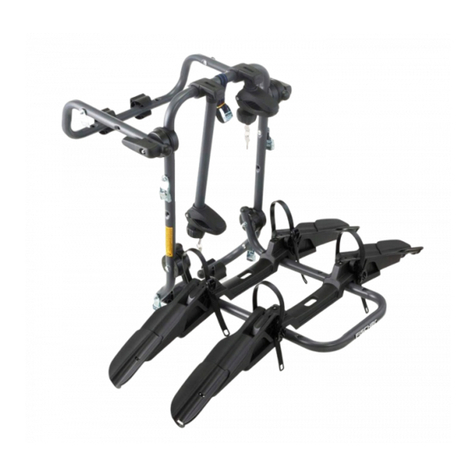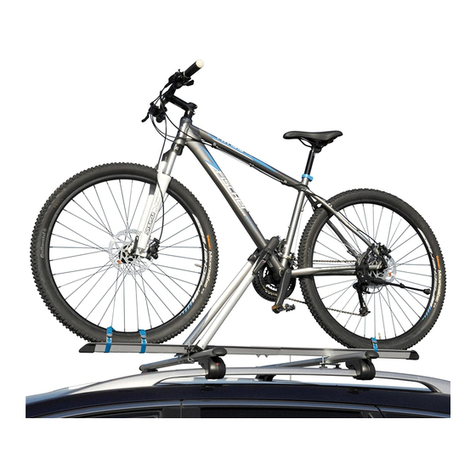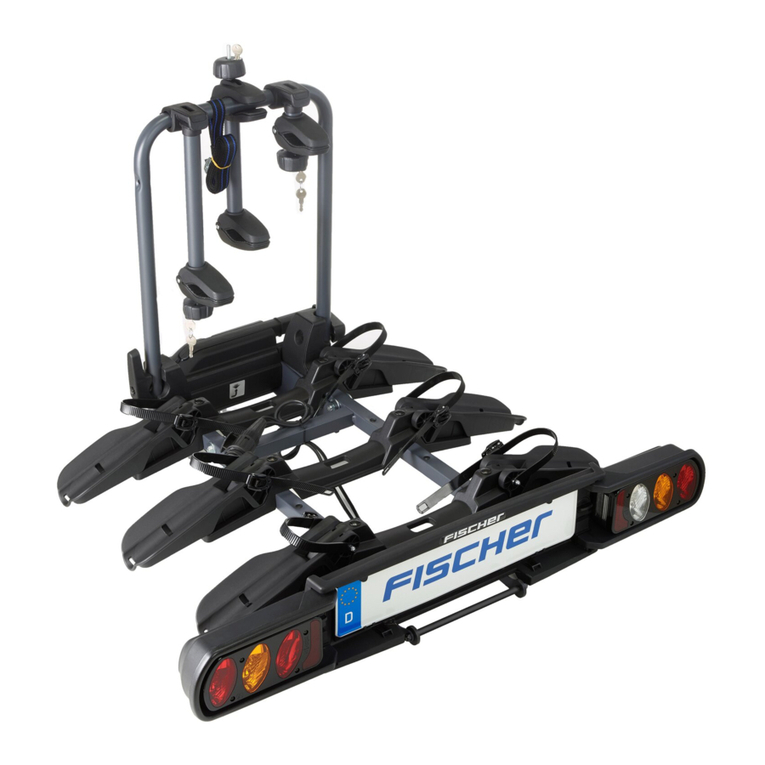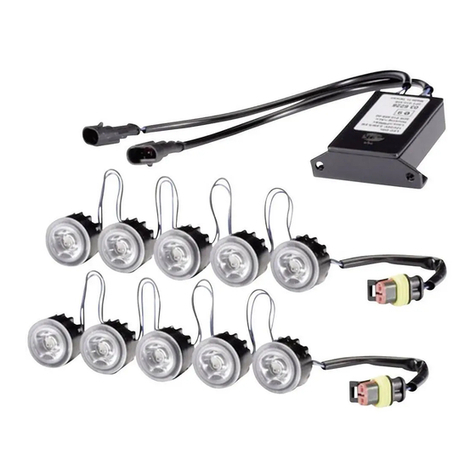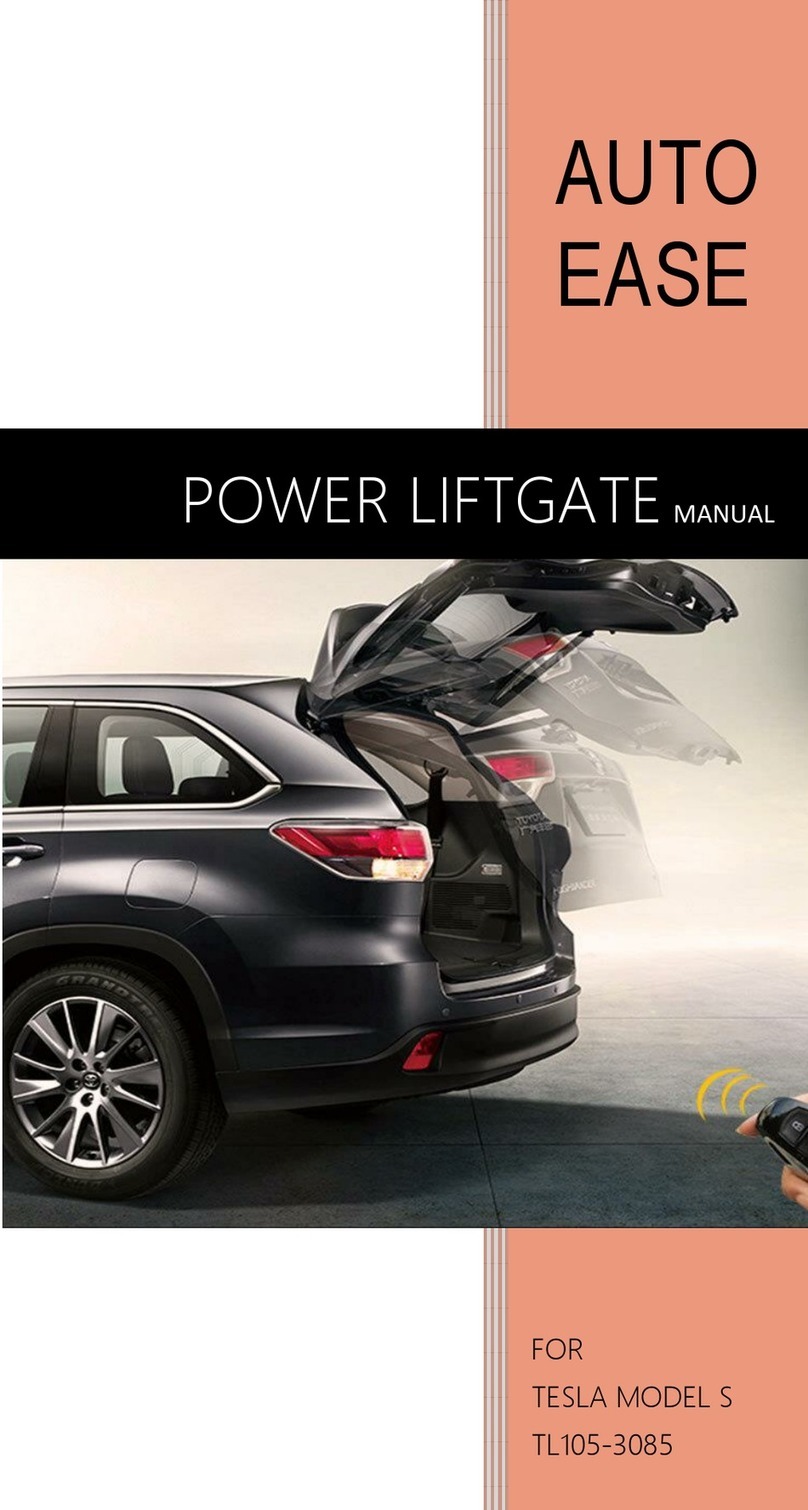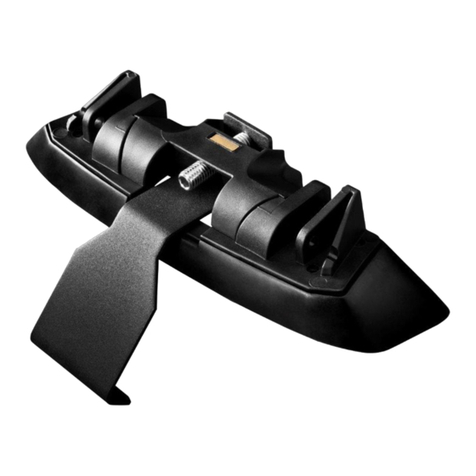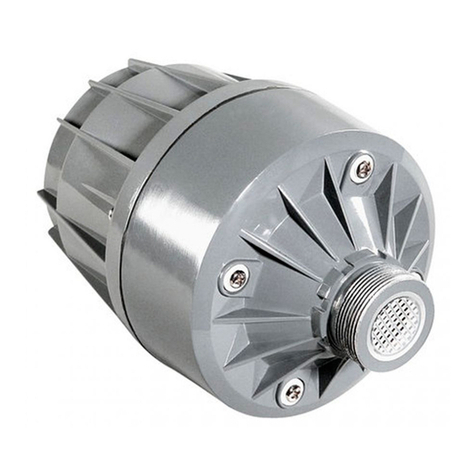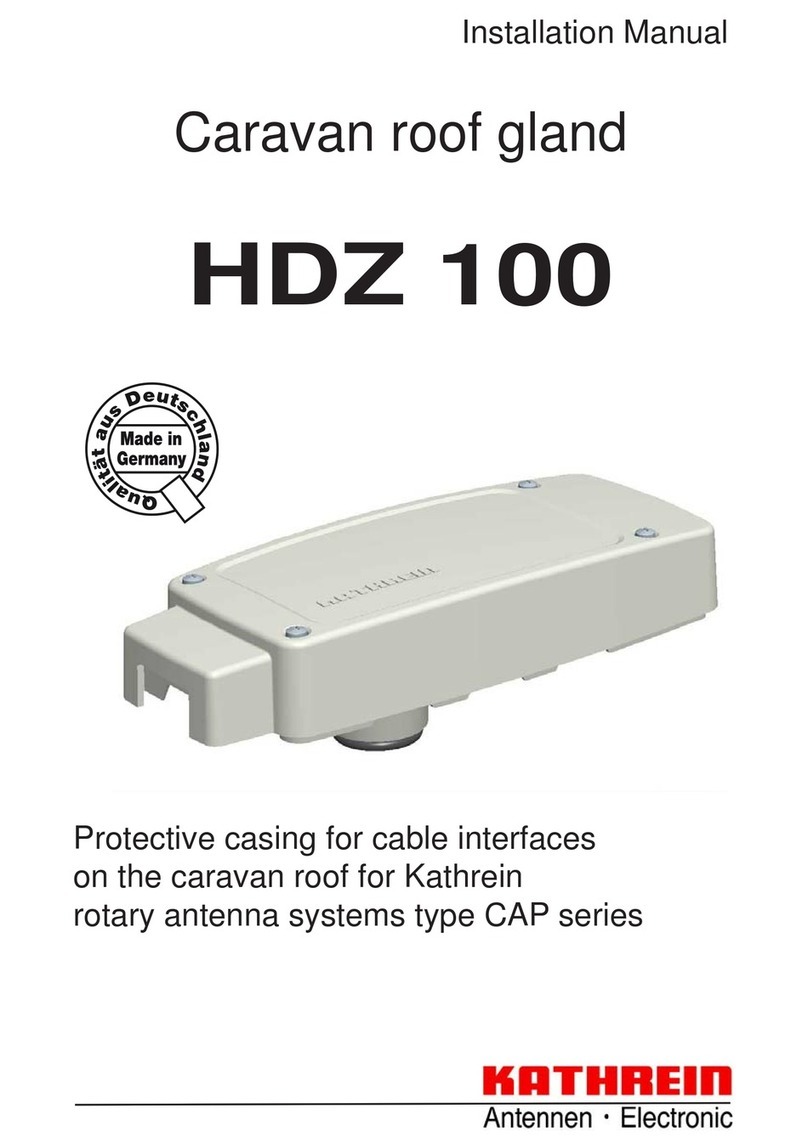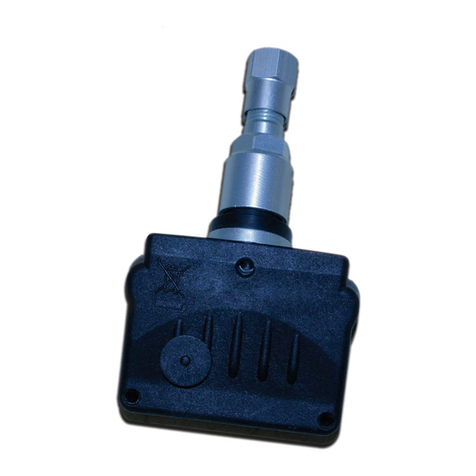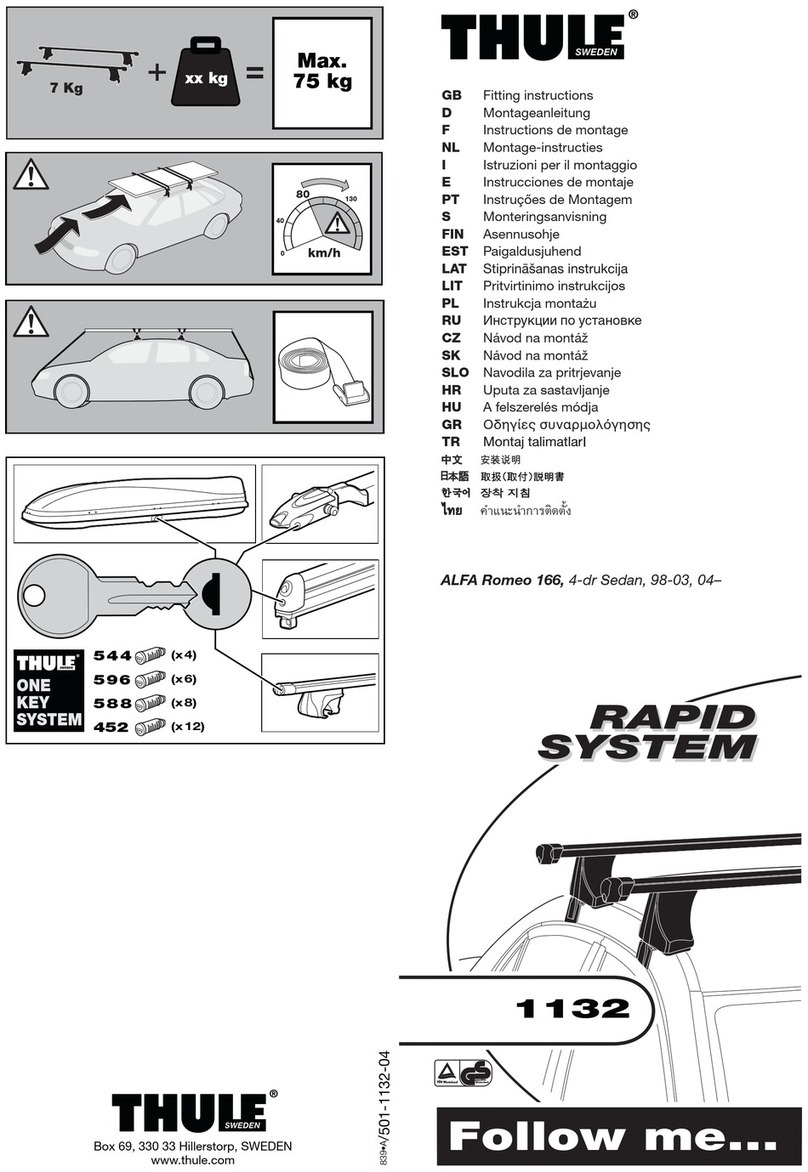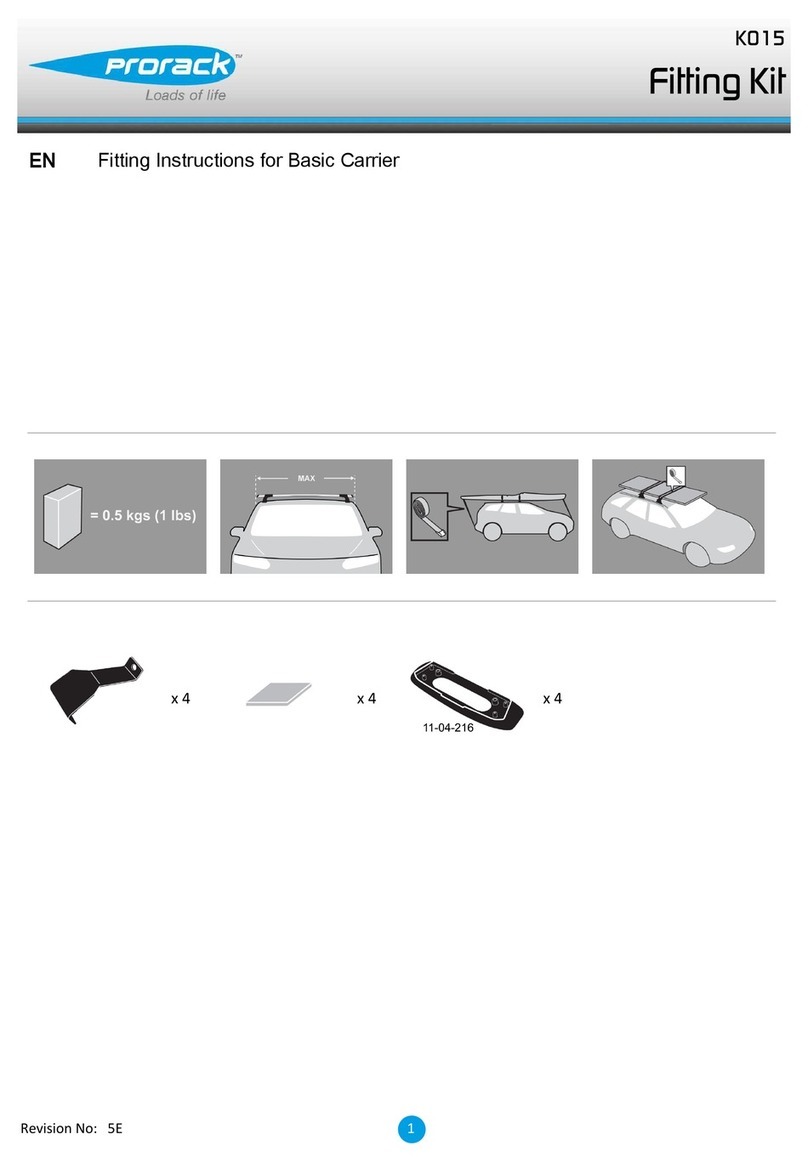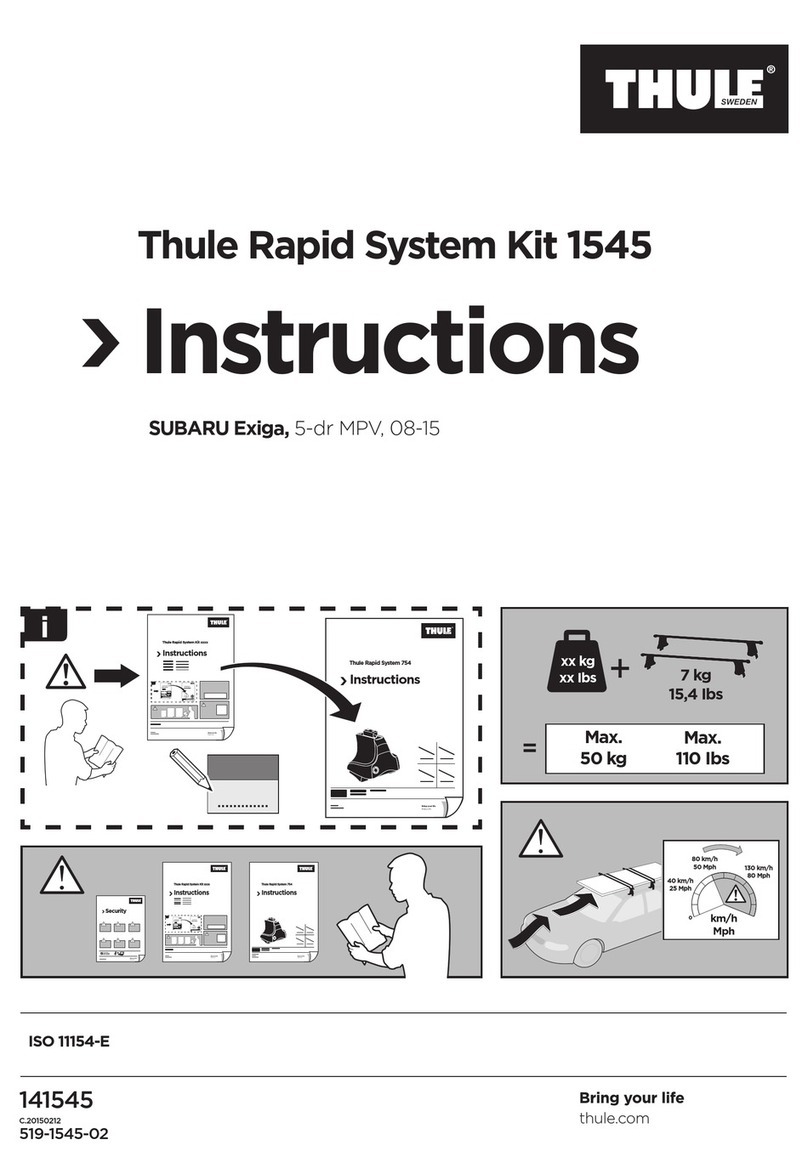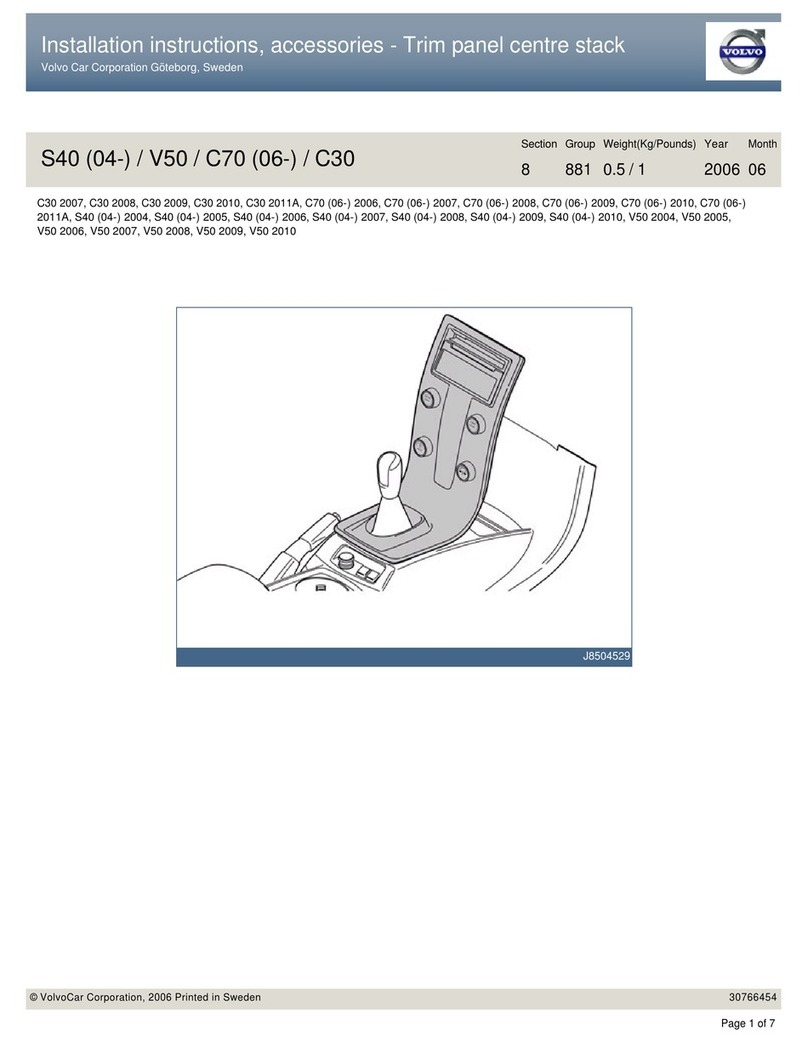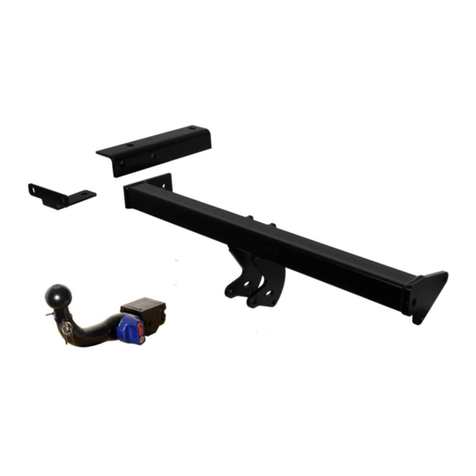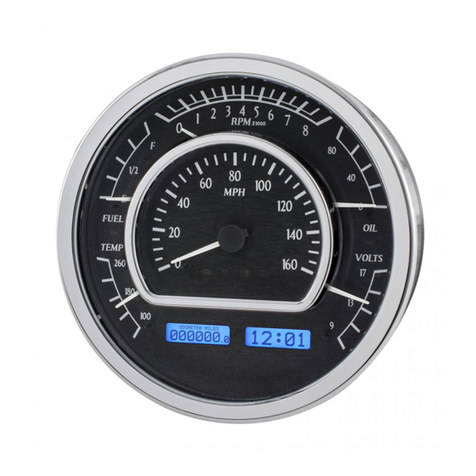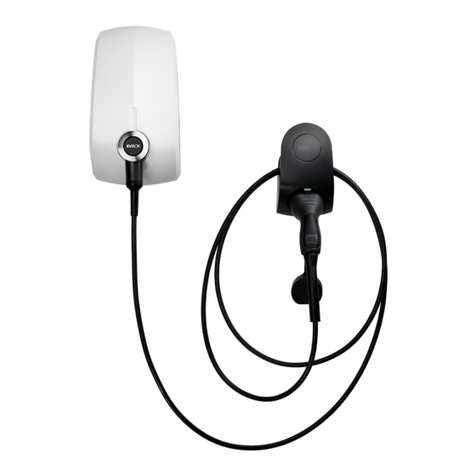FISCHER 126000 User manual

Faltbare Dachbox
Originalbetriebsanleitung
1. Sicherheitshinweise.............................................................................02 – 03
2. Zusammenbauen.................................................................................12 – 15
Folding roof box
Original instructions
1. Safety instructions...............................................................................04 – 05
2. Assembly.............................................................................................12 – 15
Coffre de toit pliable
Mode d’emploi original
1. Consignes de sécurité.........................................................................06 – 07
2. Assemblage.........................................................................................12 – 15
Box da tetto pieghevole
Manuale d’uso originale
1. Precauzioni di sicurezza......................................................................08 – 09
2. Montaggio............................................................................................12 – 15
Składany bagażnik dachowy typu box
Tłumaczenie oryginalnej instrukcji obsług
1. Wskazówki dotyczące bezpieczeństwa użytkowania..........................10 – 11
2. Montaż.................................................................................................12 – 15
D
GB
F
I
PL
Art.-Nr. 126000 - 07/2020
Faltbare Dachbox
126000INT_FZ_FISCHER_Faltbare_Dachbox_BAL_200710.indd 1126000INT_FZ_FISCHER_Faltbare_Dachbox_BAL_200710.indd 1 10.07.20 11:3010.07.20 11:30

2
Sehr geehrte Kunden,
Vielen Dank, dass Sie sich für die Fischer faltbare Dachbox entschieden haben.
Sie müssen die faltbare Dachbox vor der ersten Verwendung sorgfältig anhand
dieser Betriebsanleitung montieren.
HINWEIS: Lesen Sie unbedingt diese Betriebsanleitung sorgfältig durch, bevor Sie mit der Montage der
Dachbox beginnen! Beachten Sie besonders die Sicherheitshinweise!
• Betriebsanleitung während der Lebensdauer des Produktes aufbewahren
• Betriebsanleitung an die nachfolgenden Besitzer und Nutzer des Produktes weitergeben
WICHTIG: Beachten Sie die Angaben Ihres PKW-Herstellers zur höchstzulässigen Dachlast. Zudem
müssen Sie die Angabe des Herstellers zur max. zulässigen Tragfähigkeit des Relingträgers beachten.
Diese Dachbox wurde mit Sorgfalt und entsprechend den Sicherheitsvorschriften in Anlehnung an DIN 75302
entwickelt, gebaut und geprüft.
Technische Daten:
• Eigengewicht der Dachbox: 6 kg
• max. Zuladung: 44 kg
• max. Gesamtgewicht: 50 kg
1. Sicherheitshinweise
• Wenn Sie mit einer Dachlast auf Ihrem Fahrzeug unterwegs sind, vergessen Sie nicht, dass Sie Überhöhe haben und
seien Sie besonders vorsichtig, bevor Sie in Tunnel, Unterführungen, Garagen,Parkhäuser usw. einfahren.
• Nach einer kurzen Fahrtstrecke die korrekte Befestigung der gesamten Gruppe, die richtige Spannung der Gurte und
die Festigkeit der verschiedenen Schrauben kontrollieren; dann über die gesamte Strecke regelmäßige Kontrollen
durchführen. Je nach Beschaffenheit der Fahrbahn sind häugere Kontrollen erforderlich.
• Mit der Zeit können die Gurte und Schrauben Zeichen von Abnutzung aufweisen. In diesem Fall müssen sie sofort
ersetzt werden.
• Achten Sie darauf, dass sich das Fahr- und Bremsverhalten des Fahrzeugs bei vorhandener Ladung ändert und daher
die Geschwindigkeit zu mindern und die Fahrweise anzupassen ist.
• Seitenwind, plötzliches Bremsen, enge Kurven, hohe Geschwindigkeit, Kuppen und Schlaglöcher bei beschädigtem
Straßenbelag ändern das Fahrverhalten des Fahrzeugs. Daher die Geschwindigkeit verringern und die gesetzlich
vorgeschriebenen Grenzgeschwindigkeiten einhalten. Auf keinen Fall schneller als 130 km/h fahren.
• Der Hersteller übernimmt keine Haftung für Schäden, die sich aus der hohen Geschwindigkeit des Fahrzeugs oder
einem unkorrekten Fahrverhalten ergeben.
• Vor Antritt jeder Fahrt und auch regelmäßig während des Transports ist sicherzustellen, dass die Befestigungselemente
und die Schraubbolzen sicher geschlossen sind und die Ladung einen sicheren Zustand aufweist.
• Die Ladung ist gegen Verrutschen zu sichern.
• Die Dachbox muss bei Fahrtantritt immer sicher und dicht verschlossen sein.
• Schwer einsehbare Gegenstände dürfen nicht über das Prol hinausragen.
• Die Dachbox ist stets mit der Öffnungsseite nach hinten auf dem Dach zu montieren.
• Aus Sicherheitsgründen muss die Dachbox so montiert werden, dass das Be- und Entladen von der Beifahrerseite
erfolgen kann.
• Die Dachbox ist – zur Vermeidung erhöhter Auftriebskräfte – in Fahrtrichtung ohne Anstellwinkel zu montieren.
• Aus Gründen der Sicherheit anderer Verkehrsteilnehmer und der Energieeinsparung ist die Dachbox bei
Nichtbenutzung vom Fahrzeug abzunehmen.
• Dachbox beim Waschen des Fahrzeugs abmontieren.
• Dachbox nicht mit Gegenständen abdecken, die durch die Windkraft abgetrennt werden können.
• Dieses System erfordert einen sorgfältigen Zusammenbau sowie die strikte Einhaltung der Montage- und
Benutzungsanleitungen. Während des Transports mit Ihrem Fahrzeug sind Sie immer für Ihre Sicherheit und die
Sicherheit von Dritten verantwortlich.
• Die im Bestimmungsland geltenden Vorschriften beachten.
• Informieren Sie jeden anderen Fahrer, der Ihre Dachbox benutzt, über diese Hinweise.
Warnung
D
126000INT_FZ_FISCHER_Faltbare_Dachbox_BAL_200710.indd 2126000INT_FZ_FISCHER_Faltbare_Dachbox_BAL_200710.indd 2 10.07.20 11:3010.07.20 11:30

1. Sicherheitshinweise
Kinder (auch beim
Spiel) nicht beladen/
transportieren
Kein Eisen oder
schwere Objekte
transportieren
Keine Gegenstände
mit Spitzen
transportieren
Keine Flüssigkeit
oder Lösungsmittel
transportieren
Personen (auch beim
Spiel) nicht beladen/
transportieren
Keine gefährliche
Gegenstände
mit Spitzen
transportieren
Kein Lebensmittel
transportieren
Kein brennbares
Material
transportieren
Tiere nicht beladen/
transportieren
Keine Ziegel
transportieren
Kein pulverisiertes
Material, Sand,
Zement, Kalk, usw.
transportieren
Kein explosives
Material
transportieren
= 50 kg
max.
Speed
130 km/h max.
= 6 kg
126000INT_FZ_FISCHER_Faltbare_Dachbox_BAL_200710.indd 3126000INT_FZ_FISCHER_Faltbare_Dachbox_BAL_200710.indd 3 10.07.20 11:3010.07.20 11:30

4
• When driving your car with a loaded roof, do not forget that your vehicle is higher than usual. Be particularly careful
when entering tunnels, underpasses, garages, car parks, etc.
• After having driven a short distance, check to make sure that the entire system is correctly fastened, the belts are
adjusted correctly and that all screws are tightened. Carry out regular checks over the duration of your journey.
Additional checks may be necessary depending on the condition of the road surface.
• Over time, the straps and screws may start to show signs of wear. They must be replaced as soon as any deterioration
in quality is visible.
• Be aware that driving conditions and the braking response will change according to the load on the vehicle. Adapt your
driving style and reduce your speed when driving with any load on the roof.
• Cross winds, sudden braking, tight curves, high speeds and driving over hilltops and uneven road surfaces alter the
driving conditions of the vehicle. Reduce your speed and always observe the legal speed limit. Do not under any
circumstances let your speed exceed 130 km/h.
• The manufacturer cannot be held responsible for any damage caused as the result of driving at high speed or incorrect
driver behaviour.
• Ensure that the anchoring elements and the bolts are tight and the load is secured correctly both before setting off and
regularly during your journey.
• Ensure the load is secure and cannot slip.
• Ensure the roof box is securely closed before starting your journey.
• Difcult to see objects must not protrude beyond the prole.
• The roof box must always be assembled with the side that opens facing the back of the vehicle.
• For safety reasons, the roof box must be assembled so that it can be loaded and unloaded from the passenger side
of the vehicle.
• In order to avoid increased lift, the roof box must be assembled perfectly at in the direction of travel.
• In order to protect other road users and to increase fuel efciency, the roof box should be removed when not in use.
• The roof box should be removed when cleaning the vehicle.
• Do not cover the roof box with any items which can become dislodged as a result of wind.
• This system requires careful assembly and strict adherence to the assembly and operating instructions. Remember that
you are responsible for your own safety and for the safety of others when transporting anything using the roof box.
• You must comply with local regulations at all times.
• You are responsible for informing any other drivers using the roof box of these instructions.
1. Safety instructions
GB Dear customer,
thank you for buying the Fischer folding roof box.
Please make sure you assemble the folding roof box according to these instructions
before using it for the first time.
NOTE: read these operating instructions carefully before starting to assemble your new roof box.
Observe all safety instructions.
• Keep the operating instructions for the entire service life of the product
• Pass on the instructions onto the new owner or user of the product if sold or borrowed
IMPORTANT NOTE: Refer to the car manufacturer‘s guidelines on the maximum permissible load on the
roof. You will also need to comply with the manufacturer‘s guidelines for the maximum permissible load on the
roof bars. This roof box was carefully developed, manufactured and tested according to safety regulations based on
DIN 75302.
Technical data:
• Weight of roof box: 6 kg
• Max. load: 44 kg
• Max. total weight: 50 kg
Warning
126000INT_FZ_FISCHER_Faltbare_Dachbox_BAL_200710.indd 4126000INT_FZ_FISCHER_Faltbare_Dachbox_BAL_200710.indd 4 10.07.20 11:3010.07.20 11:30

The roof box is not
a toy. Never put
children in the roof
box
Do not use the roof
box to transport
iron or other heavy
objects
Do not use the roof
box to transport
pointed items
Do not use the roof
box to transport
liquids or solvents
The roof box is not
a toy. Never put any
person in the roof
box
Do not use the roof
box to transport
dangerous items with
sharp edges
Do not use the roof
box to transport
food
Do not use the roof
box to transport
ammable material
Do not use the roof
box to transport
animals
Do not use the roof
box to transport
bricks
Do not use the roof
box to transport any
powdered material
(e.g. sand, cement,
lime, etc.)
Do not use the roof
box to transport
explosive material
1. Safety instructions
= 50 kg
max.
Speed
130 km/h max.
= 6 kg
126000INT_FZ_FISCHER_Faltbare_Dachbox_BAL_200710.indd 5126000INT_FZ_FISCHER_Faltbare_Dachbox_BAL_200710.indd 5 10.07.20 11:3010.07.20 11:30

6
Chers clients,
Merci beaucoup d‘avoir opté pour le coffre de toit pliable de Fischer.
Vous devez monter le coffre de toit pliable avec soin à l‘aide de cette notice
avant la première utilisation.
REMARQUE : lisez cette notice d‘utilisation avec soin avant de commencer le montage du coffre de toit !
Respectez en particulier les consignes de sécurité !
• Conserver la notice d‘utilisation pendant la durée de vie du produit
• Transmettre la notice d‘utilisation au propriétaire et utilisateur suivant du produit
IMPORTANT : respectez les indications de votre constructeur automobile pour la charge de toit maximale.
En outre, vous devez respecter ses indications concernant la capacité de charge maximale admissible du
support de galerie. Ce coffre de toit a été conçu, construit et testé avec soin et conformément aux prescriptions de
sécurité sur base de la norme DIN 75302.
Caractéristiques techniques :
• Poids propre du coffre de toit : 6 kg
• Charge max. : 44 kg
• Poids total max. : 50 kg
• Si vous roulez avec un coffre de toit sur votre véhicule, n‘oubliez pas que la hauteur de ce dernier a été augmentée et
soyez particulièrement prudent avant d‘emprunter un tunnel, des passages souterrains, des garages, des parkings, etc.
• Après avoir effectué un court trajet, contrôler la xation correcte de l‘ensemble du groupe, la tension correcte des
sangles et le serrage correct des différentes vis ; ensuite, exécuter des contrôles réguliers sur le trajet. Selon l‘état de
la route, des contrôles plus fréquents sont nécessaires.
• Avec le temps, les courroies et les vis peuvent présenter des signes d‘usure. Dans ce cas, vous devez les remplacer
sans attendre.
• Attention à ce que le comportement routier et de freinage du véhicule change avec la charge. Il faut donc modérer la
vitesse et adapter la conduite.
• Le vent latéral, un freinage brusque, des virages serrés, une vitesse élevée, des cassis et des trous dans la route en
raison de la dégradation du revêtement routier modient le comportement routier du véhicule. Il faut donc réduire la
vitesse et respecter les limitations de vitesse prescrites légalement. En aucun cas, ne rouler à plus de 130 km/h.
• Le constructeur n‘assume aucune garantie pour les dommages qui résultent d‘une vitesse élevée du véhicule ou d‘un
comportement routier incorrect.
• Avant chaque trajet et régulièrement pendant celui-ci, il faut s‘assurer que les éléments de xation et les boulons sont
bien serrés et que le chargement présente un état sûr.
• Le chargement doit être assuré contre le glissement.
• Le coffre de toit doit toujours être fermé de manière sûre et étanche avant de prendre la route.
• Des objets difcilement perceptibles ne peuvent pas dépasser du prol.
• Le coffre de toit doit toujours être monté avec le côté d‘ouverture dirigé vers l‘arrière.
• Pour des raisons de sécurité, le coffre de toit doit être monté de manière à ce que le chargement et le déchargement
puissent s‘effectuer du côté du passager.
• Le coffre de toit doit être monté dans le sens de la marche sans angle d‘incidence (ceci pour éviter des efforts de
sustentation supplémentaires).
• Pour la sécurité des autres conducteurs et pour économiser l‘énergie, le coffre de toit doit être enlevé du véhicule en
cas de non-utilisation.
• Démonter le coffre de toit lors du lavage du véhicule.
• Ne pas recouvrir le coffre de toit d‘objets qui peuvent être détachés par la force du vent.
• Ce système exige un montage soigneux, de même que le strict respect des instructions de montage et d‘utilisation.
Pendant le transport avec votre véhicule, vous êtes toujours responsables de votre sécurité et de celle des tiers.
• Les prescriptions applicables dans le pays de destination doivent être respectées.
• Informez aussi tout conducteur qui utilise le coffre de toit sur ces consignes.
Avertissement
F
1. Consignes de sécurité
126000INT_FZ_FISCHER_Faltbare_Dachbox_BAL_200710.indd 6126000INT_FZ_FISCHER_Faltbare_Dachbox_BAL_200710.indd 6 10.07.20 11:3010.07.20 11:30

Ne pas charger/
transporter des
enfants (même par
jeu)
Ne pas transporter
de fer ni d‘objets
lourds
Ne pas transporter
d‘objets pointus
Ne pas transporter
de liquides ou de
solvants
Ne pas charger/
transporter des
personnes (même
par jeu)
Ne pas transporter
d‘objets pointus
dangereux
Ne pas transporter
d‘aliments
Ne pas transporter
de matériaux
inammables
Ne pas charger/
transporter des
animaux
Ne pas transporter
de briques
Ne pas transporter de
matériaux pulvérisés,
de sable, de ciment,
de chaux, etc.
Ne pas transporter de
matériaux explosifs
1. Consignes de sécurité
= 50 kg
max.
Vitesse de
130 km/h max.
= 6 kg
126000INT_FZ_FISCHER_Faltbare_Dachbox_BAL_200710.indd 7126000INT_FZ_FISCHER_Faltbare_Dachbox_BAL_200710.indd 7 10.07.20 11:3010.07.20 11:30

8
Gentile cliente,
grazie per avere scelto il box da tetto pieghevole Fischer.
Al primo impiego montare accuratamente il box da tetto pieghevole seguendo
il presente manuale d‘uso.
AVVERTENZA: prima di iniziare il montaggio del box da tetto, leggere attentamente e interamente questo
manuale d‘uso! Prestare attenzione in particolare alle avvertenze di sicurezza!
• Conservare il manuale d‘uso per tutta la vita del prodotto
• Consegnare il manuale d‘uso agli eventuali successivi proprietari e utilizzatori del prodotto
IMPORTANTE: osservare i dati del produttore della propria autovettura relativi al massimo carico ammesso
sul tetto. Osservare inoltre i dati del produttore relativi alla portata max. ammessa delle barre portatutto.
Questo box da tetto è stato sviluppato, prodotto e controllato scrupolosamente e conformemente alle norme di
sicurezza secondo la norma DIN 75302.
Dati tecnici:
• Peso proprio del box da tetto: 6 kg
• Carico utile max.: 44 kg
• Peso totale max.: 50 kg
• Quando viaggiate con un carico sul tetto della vostra autovettura, non dimenticate che avete una extra altezza, usate
perciò prudenza specialmente all’ingresso in gallerie, sottopassaggi, garage, parcheggi multipiano ecc.
• Dopo avere percorso un primo breve tratto di strada, controllare il corretto ssaggio dell’intero gruppo, la giusta
tensione delle cinghie e il ssaggio delle diverse viti; effettuare in seguito controlli regolari lungo l’intero percorso.
Controlli più frequenti sono necessari a seconda della qualità della carreggiata.
• Con il tempo le cinghie e le viti possono presentare segni di usura. In tal caso devono essere immediatamente
sostituite.
• Attenzione, in presenza del carico sul tetto il comportamento di guida e di frenata del veicolo cambia ed è perciò
necessario ridurre la velocità e adeguare lo stile di guida.
• Vento laterale, frenate improvvise, curve strette, velocità elevata, dossi e buche nel caso di manto stradale danneggiato
cambiano il comportamento su strada dell’autoveicolo. Ridurre perciò la velocità e rispettare i limiti di velocità prescritti
dalla legge. Non superare mai 130 km/h.
• Il produttore declina qualsiasi responsabilità per danni derivanti dall’elevata velocità dell’autoveicolo o da un
comportamento di guida non corretto.
• Prima di mettersi in viaggio, e anche regolarmente durante il trasporto, accertarsi sempre che gli elementi di ssaggio
ed i bulloni siano saldamente bloccati ed il carico sia in condizioni di sicurezza.
• Il carico deve essere ssato contro lo slittamento.
• All’inizio del viaggio il box da tetto deve essere sempre chiuso correttamente e ermeticamente.
• Gli oggetti difcili da vedere non devono sporgere oltre il prolo.
• Il box da tetto deve essere montato sul tetto sempre con il lato apribile rivolto indietro.
• Per motivi di sicurezza il box da tetto deve essere montato in modo che il carico e scarico sia possibile dal lato
passeggero.
• Al ne di evitare elevate forze ascensionali, nella direzione di marcia il box da tetto deve essere montato senza angolo
di incidenza.
• Per motivi di sicurezza di altri utenti della strada e di risparmio energetico, se non utilizzato, il box da tetto deve essere
smontato dall’autoveicolo.
• Per lavare il veicolo smontare il box da tetto.
• Non coprire il box da tetto con oggetti, che possono essere staccati dalla forza del vento.
• Questo sistema richiede uno scrupoloso assemblaggio, nonché il preciso rispetto delle istruzioni per il montaggio e
l’uso. Durante il trasporto con il vostro autoveicolo siete sempre responsabili della vostra sicurezza e della sicurezza
di terzi.
• Osservare le norme vigenti nel paese di destinazione.
• Informate di queste avvertenze ogni altro conducente, che utilizza il vostro box da tetto.
Avviso
I
1. Precauzioni di sicurezza
126000INT_FZ_FISCHER_Faltbare_Dachbox_BAL_200710.indd 8126000INT_FZ_FISCHER_Faltbare_Dachbox_BAL_200710.indd 8 10.07.20 11:3010.07.20 11:30

Non caricare/
trasportare bambini
(nemmeno per gioco)
Non trasportare
ferro oppure oggetti
pesanti
Non caricare oggetti
con punte
Non trasportare
liquidi o solventi
Non caricare/
trasportare persone
(nemmeno per gioco)
Non trasportare
oggetti pericolosi
con punte
Non trasportare
generi alimentari
Non trasportare
materiale
inammabile
Non caricare/
trasportare animali
Non trasportare
laterizi
Non trasportare
materiale polverizzato,
sabbia, cemento,
calcare, ecc.
Non trasportare
materiale esplosivo
= 50 kg
max.
Velocità
130 km/h max.
= 6 kg
1. Precauzioni di sicurezza
126000INT_FZ_FISCHER_Faltbare_Dachbox_BAL_200710.indd 9126000INT_FZ_FISCHER_Faltbare_Dachbox_BAL_200710.indd 9 10.07.20 11:3010.07.20 11:30

10
Szanowny Kliencie!
Dziękujemy, że wybrałeś składany bagażnik dachowy typu box marki Fischer.
Przed pierwszym użyciem składanego bagażnika dachowego należy go starannie
zamontować, stosując się do informacji zawartych w niniejszej instrukcji obsługi.
WSKAZÓWKA: przed rozpoczęciem montażu bagażnika koniecznie zapoznaj się dokładnie z niniejszą
instrukcją obsługi! Zwróć uwagę w szczególności na wskazówki dotyczące bezpieczeństwa!
• Zachowaj instrukcję obsługi do czasu użytkowania produktu
• Przekaż instrukcję obsługi kolejnym posiadaczom i użytkownikom produktu.
WAŻNE: należy przestrzegać wytycznych producenta samochodu osobowego dotyczących maksymalnie
dopuszczalnego obciążenia dachu, jak również maks. dopuszczalnego obciążenia relingów. Ten bagażnik
dachowy typu box został zaprojektowany, stworzony i sprawdzony z należytą starannością oraz zgodnie z przepisami
dotyczącymi bezpieczeństwa w oparciu o normę DIN 75302.
Dane techniczne:
• ciężar własny bagażnika dachowego typu box: 6 kg
• maks. ciężar ładunku: 44 kg
• maks. ciężar całkowity: 50 kg
• Podczas podróżowania z bagażem na dachu pamiętaj, że pojazd jest wyższy; przed wjazdem do tunelów, przejazdów
podziemnych, garaży, parkingów wielopoziomowych itp. należy zachować szczególną ostrożność.
• Po przejechaniu krótkiego odcinka sprawdź prawidłowe zamocowanie całego zespołu, odpowiednie napięcie pasów
oraz stabilność śrub; następnie podczas całej trasy przeprowadzaj regularne kontrole. W zależności od stanu jezdni
mogą być potrzebne częstsze kontrole.
• Z czasem pasy i śruby mogą wykazywać ślady zużycia. W takim wypadku należy je niezwłocznie wymienić.
• Zwróć uwagę, że podczas przewożenia ładunku właściwości jezdne i właściwości hamowania pojazdu ulegają zmianie
i dlatego konieczne jest zmniejszenie prędkości i odpowiednie dostosowanie stylu jazdy.
• Wiatr boczny, nagłe hamowanie, ciasne zakręty, wysoka prędkość, wzniesienia i dziury w uszkodzonej nawierzchni
— to czynniki, które zmieniają właściwości jezdne pojazdu. Dlatego należy zredukować prędkość i przestrzegać
określonych ustawowo prędkości granicznych. W żadnym wypadku nie jechać szybciej niż 130 km/h.
• Producent nie ponosi odpowiedzialności za szkody powstałe w wyniku jazdy z wysoką prędkością lub nieprawidłowego
zachowania podczas jazdy.
• Przed rozpoczęciem każdej jazdy, a także regularnie w trakcie transportu, należy zadbać o to, aby elementy mocujące
oraz gwinty śrubowe były pewnie przytwierdzone, a stan ładunku wskazywał, że jest on odpowiednio zabezpieczony.
• Ładunek należy zabezpieczyć przed przesuwaniem.
• Przed rozpoczęciem jazdy bagażnik dachowy musi być zawsze pewnie i szczelnie zamknięty.
• Trudno zauważalne przedmioty nie mogą wystawać poza prol.
• Bagażnik dachowy należy montować na dachu zawsze stroną z otworem skierowaną do tyłu.
• Ze względów bezpieczeństwa bagażnik należy zamontować w ten sposób, aby załadowanie i wyładowanie było
możliwe od strony pasażera.
• Bagażnik należy zamontować w kierunku jazdy bez kąta natarcia – w celu uniknięcia zwiększonej siły wyporu.
• Ze względu na bezpieczeństwo innych uczestników ruchu drogowego oraz na oszczędzanie energii, w razie
nieużytkowania bagażnika należy zdjąć go z dachu pojazdu.
• Na czas mycia pojazdu zdemontować bagażnik dachowy.
• Nie nakrywać bagażnika przedmiotami, które mogłyby zostać oddzielone przez siłę wiatru.
• Ten system wymaga starannej instalacji oraz ścisłego przestrzegania instrukcji montażu i instrukcji obsługi. Podczas
transportu ładunku własnym samochodem jesteś zawsze odpowiedzialny za bezpieczeństwo swoje i osób trzecich.
• Należy przestrzegać przepisów obowiązujących w kraju przeznaczenia.
• Każdego innego kierowcę użytkującego bagażnik dachowy należy poinformować o niniejszych wskazówkach.
Ostrzeżenie
1. Wskazówki dotyczące bezpieczeństwa użytkowania
PL
126000INT_FZ_FISCHER_Faltbare_Dachbox_BAL_200710.indd 10126000INT_FZ_FISCHER_Faltbare_Dachbox_BAL_200710.indd 10 10.07.20 11:3010.07.20 11:30

Do bagażnika
nie wkładać / nie
przewozić w nim
dzieci (także dla
zabawy)
Nie przewozić
żelaza i ciężkich
przedmiotów
Nie przewozić
przedmiotów z
ostrymi końcami
Nie przewozić cieczy
i rozpuszczalników
Do bagażnika
nie wkładać / nie
przewozić w nim
osób (także dla
zabawy)
Nie przewozić
niebezpiecznych
przedmiotów z
ostrymi końcami
Nie przewozić
artykułów
spożywczych
Nie przewozić
materiału
łatwopalnego
Do bagażnika
nie wkładać / nie
przewozić w nim
zwierząt
Nie przewozić
cegieł
Nie przewozić
materiałów
sproszkowanych,
piasku, cementu,
wapna itp.
Nie przewozić
materiału
wybuchowego
= maks.
50 kg
maks. prędkość
130 km/h
= 6 kg
1. Wskazówki dotyczące bezpieczeństwa użytkowania
126000INT_FZ_FISCHER_Faltbare_Dachbox_BAL_200710.indd 11126000INT_FZ_FISCHER_Faltbare_Dachbox_BAL_200710.indd 11 10.07.20 11:3010.07.20 11:30

12
Teile Nr.
Parts No.
Pièce n°
Num. parti
Nr części
2. Zusammenbauen / Assembly / Assemblage / Montaggio / Montaż
D
GB
F
I
PL
126000INT_FZ_FISCHER_Faltbare_Dachbox_BAL_200710.indd 12126000INT_FZ_FISCHER_Faltbare_Dachbox_BAL_200710.indd 12 10.07.20 11:3010.07.20 11:30

Teile Nr.
Parts No.
Pièce n°
Num. parti
Nr części
2. Zusammenbauen / Assembly / Assemblage / Montaggio / Montaż
126000INT_FZ_FISCHER_Faltbare_Dachbox_BAL_200710.indd 13126000INT_FZ_FISCHER_Faltbare_Dachbox_BAL_200710.indd 13 10.07.20 11:3010.07.20 11:30

14
2. Zusammenbauen / Assembly / Assemblage / Montaggio / Montaż
126000INT_FZ_FISCHER_Faltbare_Dachbox_BAL_200710.indd 14126000INT_FZ_FISCHER_Faltbare_Dachbox_BAL_200710.indd 14 10.07.20 11:3010.07.20 11:30

2. Zusammenbauen / Assembly / Assemblage / Montaggio / Montaż
126000INT_FZ_FISCHER_Faltbare_Dachbox_BAL_200710.indd 15126000INT_FZ_FISCHER_Faltbare_Dachbox_BAL_200710.indd 15 10.07.20 11:3010.07.20 11:30

16
22
PAP
INTER-UNION Technohandel GmbH
Carl-Benz-Straße 2 · 76761 Rülzheim · Germany · Tel.+49 (0) 7272 9801-100 · www.mts-gruppe.com
126000INT_FZ_FISCHER_Faltbare_Dachbox_BAL_200710.indd 16126000INT_FZ_FISCHER_Faltbare_Dachbox_BAL_200710.indd 16 10.07.20 11:3010.07.20 11:30
Table of contents
Languages:
Other FISCHER Automobile Accessories manuals
